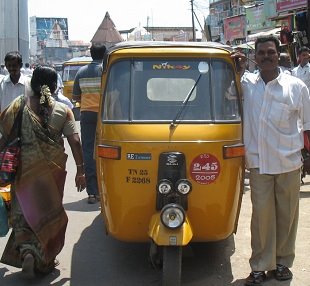
In Tiruvannamalai a common mode of transportation is the auto rickshaw. Unfortunately unlike larger cities, here rickshaw drivers are not compelled to operate meters in their vehicles. With the increased popularity of finance companies and more easily available bank loans, cars and two wheelers are much more prevalent. However for out-of-station visitors, the auto rickshaw is an essential prerequisite for getting around in Tiruvannamalai.
An auto rickshaw is generally characterized by a tin/iron body resting on three small wheels (one in front, two on the rear), a small cabin for the driver in the front and seating for two or three in the rear. Autos are generally fitted with a motorcycle version of a two-stroke engine with a handlebar for control (again like motorcycles) instead of a steering wheel, effectively making them a three-wheeler motorcycle carrying passengers on the rear seat.
For pollution control, some local governments in India are pushing for four-stroke engines instead of the current two-stroke versions. Typical mileage for an Indian-made autorickshaw is around 35 kilometres per litre of petrol.
Safety is a major concern regarding auto rickshaws. Their flimsy chassis make them dangerous to passengers even in accidents that are far from severe. They are also not well-equipped to protect their passengers from rain, air pollution or extremes of temperature. Auto rickshaws are extremely light vehicles considering their capacity.
They have a top-speed of around 50 km/h (about 31 mph) and a cruising speed of around 35 km/h (22 mph). The triangular form of the auto makes maneuvering easy, with the front single wheel negotiating the available gap, and the rear two wheels forcing a larger space.
No comments:
Post a Comment